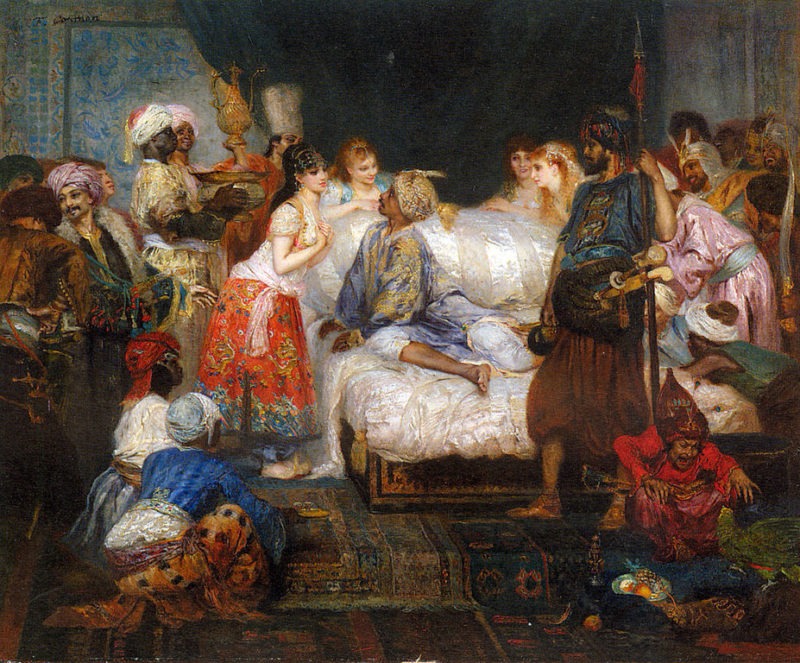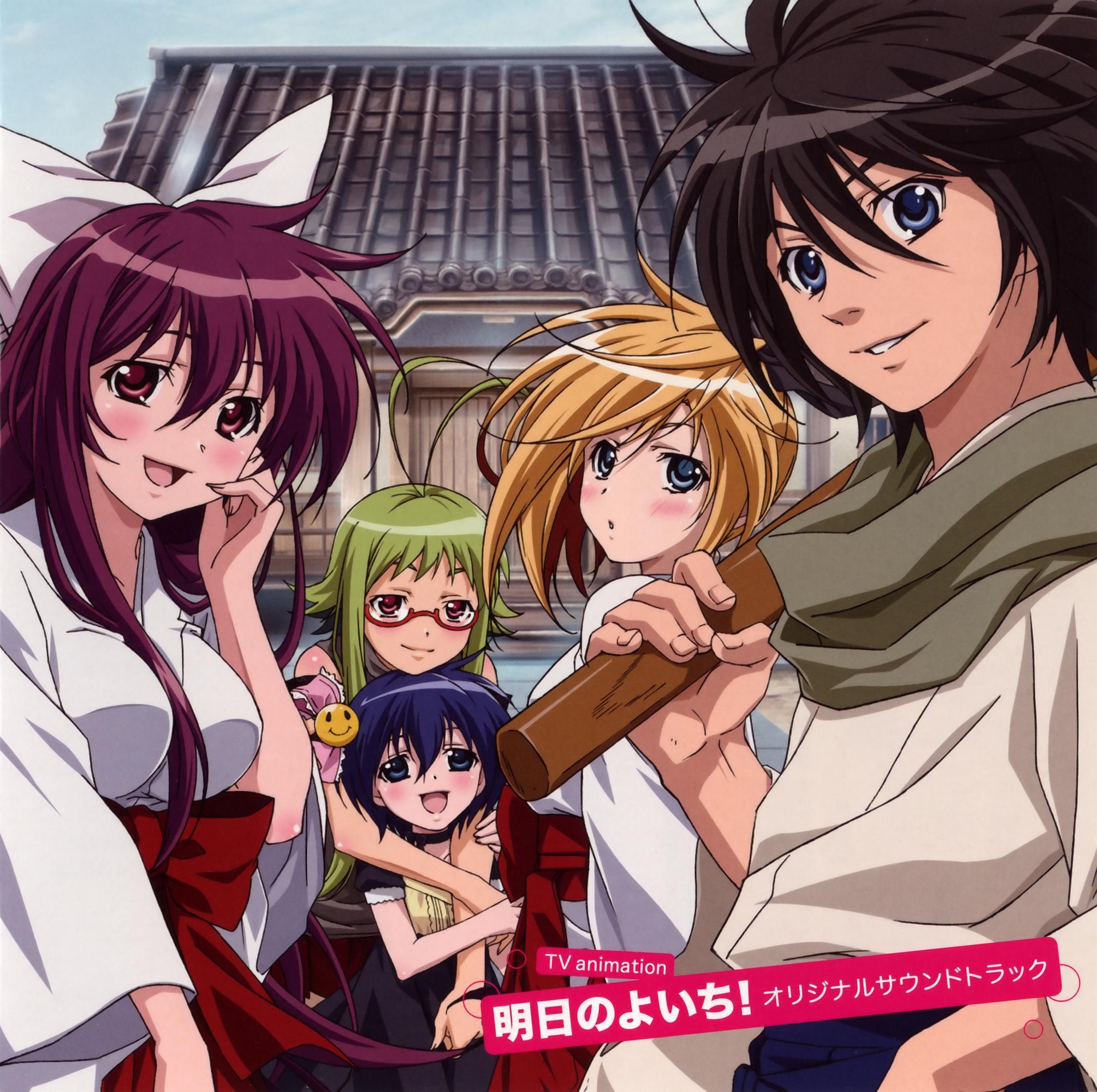
Most harem anime I’ve watched follow a template. A gaggle of various girls chase a guy with little personality and an aversion to making decisions and touching female skin. Each of the girls represent an anime trope: the tsundere, deredere, and so on. You’ll see the usual body stereotypes too, from the large-breasted girls to the self-consciously small-chested girls and of course the uncomfortably young-looking girls.
In the template, I can only describe the guy in the center of the harem as blank, average. He lacks a strong personality and is often too perfect, such as Satou in Death March to the Parallel World Rhapsody. He rarely makes mistakes, but as harem protagonists go, Satou is refreshing. First, he isn’t dense when it comes to the feelings of his harem nor does he have a fit when it comes to female skin. He decides on Zena, which is also unusual for a harem protagonist.
Harem anime differ from true harem systems. True harems of the Ottoman empire and other cultures secluded slaves, concubines, wives, and children. However, from this seclusion, women could wield political influence. A slave who bears a child of a noble could be elevated to the position of wife. These women also raised the children who vied for power with their half-siblings. When such a child became heirs, his mother (and they were almost always men) could indirectly control an entire empire (Johnson, 2013). Harem anime doesn’t involve any type of seclusion and power struggle among women and their sons.

In most harem anime, the average young man attaches to one of the girls–like Satou for Zena–but he remains confused about his feelings for the other ones. Most of the conflict centers on communication. Marriage appears as the goal, but the method to get there remains in the air (Von Felgenblatt, 2010). Harem stories rely on the tension between sexual attraction–represented by all the other girls–and romantic love–represented by the “favorite” like Zena. But this confusion ties back to communication. This time, the main man’s ability to understand and express his feelings.
Most harem protagonists are sexually repressed, or they go the extreme opposite route and become complete perverts. But both routes express a lack of understanding of emotions and communication.
Japanese men struggle to approach women and start a serious romantic relationship. “The closest to a relationship known by most young Japanese is friendship which explains the great difficulty they have in separating friendship from love” (Von Felgenblatt, 2010). They are not taught to express their feelings, making it a problem for relationships. They lack a way to expression their sexual attraction in a socially acceptable way. The Western idea of chivalric love allows Westerners to express their attraction indirectly through flattery and metaphorical hyperbole (Von Felgenblatt, 2010).
Harem anime allow these men to project themselves into the story and to sympathize with the main man. The stories explore the various problems and ways to express attraction. Of course, the stories use comedy to blunt the discomfort they may feel when a scene cuts too close to their own experiences.
For many harem protagonists, the girls act more like mothers than romantic partners, at least to Western viewers. Mothers still have a central role in Japanese culture, and many traditional husbands depend on their wives like a child depends on his mother–he depends on her for satisfying his daily routines (Kato, 1989). The concept of the ie, or house, lingers. In the model, men control the public face of the family while women control the finances and private aspects of the household. In fact (Kato, 1989):
The influence of the Japanese mother is so strong that it has led many people to regard Japanese society as “maternal” and the mother as the sole key figure in developing Japanese behavior and personality characteristics.
While Japanese relationships have modernized, the culture traditions still remain and cause tension for women who want careers. This tension makes some male viewers long for a time before these “complications.” I’ve even seen this dynamic in the United States among men who believe women should be in the home and the men out working.
Traditional wives often use guilt to control the behavior of children and husbands (Kato, 1989). If you pay attention, you’ll see this behavior in harem stories. Many of the female characters will make the protagonist feel guilty to influence his behavior–usually to make him decide on her. They coddle him in their own ways– or in the case of the tsundere attack him– because that is what traditional wives did.
Harem stories allow modern viewers to indulge traditional Japanese gender role fantasies. Multiple girls vying for attention amplifies this traditional gender role fantasy. Of course, this depends on the story too. Not all harem stories feature this.
Polygamy and Harem Anime

Harems have long been glamorized in the West. Anime harem build on this tradition.
Some people believe humans are polygamous by nature. However, this idea is incorrect. In most societies, serial monogamy, that is, when a person has only one partner at a time, was the norm. Sometimes in foraging societies the best hunters would have several wives (Driscoll, 2017). But the definition of polygamy remains a bit undefined. Biologists consider a variety of mating systems as polygamy. “A mating system in an animal group is polygamous where individuals have more than one sexual partner (Driscoll, 2017).” So according to this definition, serial monogamy can be considered polygamy.
Most historical cases of polygamy deal with powerful men, much like the sultans and their harems. Polyandry, or a wife having multiple husbands, rarely happened compared to polygamy. However, in historical cases the men and women who had harems were capable and leaders. Most protagonists in harem anime wouldn’t qualify. They lack the skills, drive, and ability necessary for society to accept their harem. Their blandness may allow viewers to project, but it would also break their ability to attract a harem. Likewise polyandry happened when women wielded political and military power. Harems appear around people in power, not around plainness.
Of course, this is part of the fantasy. When viewer projects into a harem story, all of these associations come with the harem. It may not reflect in the story, but the association of possession and power and wealth remains in the unconscious. Lately, harem stories bring this possession idea to the forefront, particularly in the trapped-in-a-game stories.

In these stories, the harem doesn’t come to the protagonist out of attraction; they are acquired like in-game items. For example, Satou acquires Liza, Tama, Pochi as slaves. He treats them as equals, but they are still acquired as opposed to them pursuing him. While the pursuit method is chauvinistic, at least the females have some autonomy: they choose to pursue him. However, the acquisition harem removes this. If anything, this style comes closer to history because in these stories the protagonist is usually powerful.
Beside all of these historical links, harem anime provide sexy fun for many viewers.
Harem anime will continue to attract viewers. The genre has built-in tension and conflict, but most of the stories follow a worn-out template. But this problem extends to all genres of anime. Harem anime has the potential to address issues of objectification, power, and communication if it can move beyond projection and escapism.
References
Driscoll, Catherine (2017) Humans and Harems? Review of Out of Eden: The surprising consequences of polygamy by David Barash. Biol Philos. 32: 615-625.
Johnson, A. J. (2013). Harem System. Salem Press Encyclopedia.
Kato, Ryoko (1989) Japanese Women: Subordination or Domination? International Journal of Sociology of the Family. 19 (1) 49-57.
Von Felgenblatt, Otto (2010) A Socio-cultural Analysis of Romantic Love in Japanese Harem Animation: A Buddhist Monk, A Japanese Knight, and a Samurai. Journal of Asia Pacific Studies. 1 (5) 636-646.






Unfortunately harem anime are mostly totally stupid.
About 90% of male Japs yearn for the very act of oppressing women, which is a typical old value, like sitting in a chair in an office and letting a woman pour tea for them.
That’s what the male Japs yearn for – sitting cross-legged in a chair and smoking cigars while rubbing the tits of a naked woman, the kind of thing that the typical old gangster would do.
The desire for female dominance is the driving force behind Harem’s work.
And since it’s only a longing, a pathetic fantasy, there’s no need for a realistic foil to that fantasy.
This is why male Japs prefer the very empty and baseless harem stories.
This shows how childish and barbaric Jap society is, and how MacArthur’s “12 year old boy, Jap” argument is still valid.
The Japs are a nation that is permanently incapable of growing up.
If gun control in this country were to be lifted, we would see suicide bombers routinely using anime, manga, and video games as the reason for their attacks, just like the corrupt states in the Middle East.
The Qur’an in the Middle East extremism is a anime,manga,video game for the Japs.
What a childish and stupid country.
Generalizations like this misses the reality of nuance and doesn’t help your argument. I agree that many harem stories encourage a wrong view of women. However, exaggerating as you have doesn’t persuade those who consume the media. If you want to convince people their perspective and choice of stories may be unhealthy, it’s better to meet them where they are and try to be understanding while showing how the perspective is problematic. Calling people childish, barbaric, and the like will close their ears to your message. It does not help.
That is why liberals and the left have been defeated by the right.
The masses focus on the more sensationalist reports, words and actions, and no one will listen if they are mishandled in clean language.
The result is the creation of high-pressure right-wing administrations like Trump, Johnson and Bolsonaro.
Probably BLM would have been just “another of the usual leftist protest movements” if it hadn’t turned into a riot.
The Japs, in particular, have been completely subdued by the right and ruled by a far-right regime for eight years, as the left has responded with silence whenever the right has attacked them with falsehoods or started a riot.
If you don’t challenge them with more sensationalist methods, you will not get people’s attention and you will only sink.
The only thing there is pure thought.
It’s better to retain the moral high ground. Integrity doesn’t win in the short term, but over the trend of history, it wins. It’s hard to be patient though!
You identify yourself as a leftist, and post racist comments at the same time. You used political stuffs to cover your childish hatred towards Japanese and some groups of people you dislike. You are an idiot.